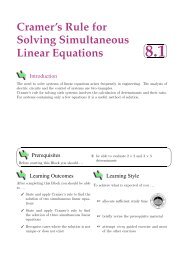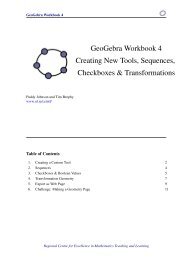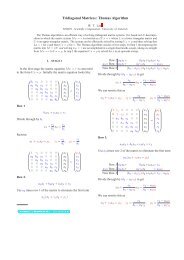Student Notes To Accompany MS4214: STATISTICAL INFERENCE
Student Notes To Accompany MS4214: STATISTICAL INFERENCE
Student Notes To Accompany MS4214: STATISTICAL INFERENCE
You also want an ePaper? Increase the reach of your titles
YUMPU automatically turns print PDFs into web optimized ePapers that Google loves.
3. A certain type of plant cell may appear in any one of four versions. According to<br />
a genetic theory, the four versions have the following probabilities of appearance:<br />
1/2 + θ/4, (1 − θ)/4, (1 − θ)/4, θ/4,<br />
where θ is a parameter not specified by the genetic theory (0 < θ < 1). If a<br />
sample of n cells had observed frequencies (a, b, c, d) where n = a + b + c + d, find<br />
the maximum likelihood estimate of θ, and an estimate of Var( ˆ θ).<br />
4. Let X1, X2, . . . , Xn be a random sample from a population with probability den-<br />
sity<br />
f(x) =<br />
(a) Show that E(X 2 ) = θ.<br />
�<br />
2<br />
πθ exp<br />
�<br />
− x2<br />
�<br />
, x > 0.<br />
2θ<br />
(b) Find the maximum likelihood estimator (MLE), ˆ θ, of θ.<br />
(c) Show that ˆ θ is an unbiased estimator of θ and that the Cramér-Rao lower<br />
bound is attained. [You may assume Var(X 2 ) = 2θ 2 .]<br />
(d) Suppose now that φ = √ θ is the parameter of interest. Without undertaking<br />
further calculations, write down the MLE of φ and explain why it is a biased<br />
estimator of φ.<br />
5. A random sample X1, X2, . . . , Xn is available from a Poisson distribution with<br />
mean θ. Define the parameter λ = e −θ .<br />
(a) Find the maximum likelihood estimator (MLE), ˆ θ, of θ. Hence deduce the<br />
MLE of ˆ λ, of λ.<br />
(b) Find the variance of ˆ θ, and deduce the approximate variance of ˆ λ using the<br />
delta method.<br />
(c) An alternative estimator of λ is ˜ λ, defines as the observed proportion of zero<br />
observations. Find the bias of ˜ λ and show that<br />
Var( ˜ λ) = e−θ � 1 − e−θ� .<br />
n<br />
(d) Draw a rough sketch of the efficiency of ˜ λ relative to ˆ λ, and discuss its<br />
properties.<br />
6. Let X1, . . . , Xn be independent and identically distributed as N (µ, σ 2 ), where µ<br />
and σ 2 are both unknown, and assume n = 2p + 1 is odd. Define the estimators<br />
ˆµ = ¯ X = (X1 + · · · + Xn)/n, ˜µ = median(X1, . . . , Xn) = X(p+1), and<br />
�<br />
�<br />
�<br />
ˆσ = S = � n �<br />
(Xi − ¯ X) 2 /(n − 1).<br />
i=1<br />
43






